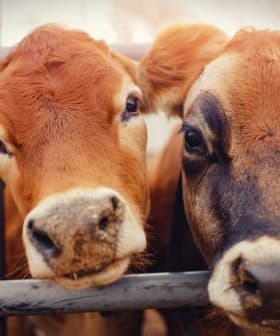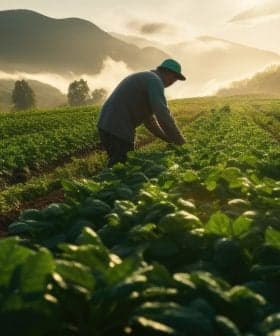European Bird Populations Threatened by Intensive Farming, Study Finds
Eliminating habitats and prey and the increasing use of fertilizer, pesticides and herbicides have contributed to the dramatic decrease in Europe’s birdlife.
 The common kingfisher (Alcedo atthis)
The common kingfisher (Alcedo atthis) A new study published in PNAS found that intensive farming in Europe has led to a 60 percent decline in bird populations since 1980, with a significant impact on insect populations crucial to bird diets. The research also highlighted the need for transformative changes in agricultural practices to mitigate the negative effects on bird species across the continent.
Intensive farming in Europe might affect bird species and population numbers more than previously thought.
A new study published in PNAS, a peer review scientific journal of the U.S. National Academy of Sciences, considers a massive amount of data retrieved in 28 European countries across 37 years.
Our results suggest that the fate of common European bird populations depends on the rapid implementation of transformative change in European societies, and especially in agricultural reform.
A team of international scientists assessed 170 common bird species in 20,000 different sites and researched how those species reacted to four sources of anthropogenic pressure: urbanization, change in forest cover, temperature change and agricultural intensification.
In the area being considered, researchers found that farmlands’ birdlife dropped by 60 percent in the four decades from 1980 to 2016.
See Also:Olive Grove Expansion Threatens Endangered Bird Species in SpainThe researchers’ goal was to establish the extent of the bird population decline and to uncover the relationships among those four different pressures and their combined impacts on birdlife. Intensive farming was singled out as the most impacting pressure.
European Union official data show that almost 40 percent of the E.U. is dedicated to agriculture. According to the researchers, such extensive farmland helps explain its potential impact on birdlife.
The new research measured intensive farming as the cover of farms with high input of pesticides and fertilizers.
“Among the reasons for the sharp decline in birds population as intensive agriculture expands, there is the significant drop in available prey, such as insects,” Federica Luoni, a biodiversity management and protection scientist at the Italian Association for the Protection of Birds and Nature (Lipu), told Olive Oil Times.
“Previous research, such as a recent study in Germany, showed how in the last 20 years, there were areas where the insect population dropped by 80 percent,” added Luoni, who is not directly involved in the new research.
Crucial insects such as pollinators are directly affected by the widespread use of chemicals in agriculture.
“We are reaching the point where some are planning manual or mechanical pollination operations where the wild insect population cannot guarantee pollination anymore,” Luoni explained.
According to the study, invertebrates are a crucial part of many bird species’ diets, especially at specific stages of their development. Of the 170 species considered, 143 depend on insects during breeding.
The researchers wrote that a highly curtailed insect population will likely affect reproduction, parental behavior and nestling survival “in addition to direct contamination by seed consumption and trophic accumulation with sublethal effect.”
“Chemicals indirectly hit birdlife by slashing available prey,” Luoni said. “But they also affect birds directly, provoking acute intoxication or, more frequently, chronic intoxication. Those are caused by several different molecules such as neonicotinoids and others that are under investigation.”
According to Luoni, in a country widely praised for its biodiversity, such as Italy, bird numbers in agricultural areas have dropped by 30 percent since 2000. If only plains are considered, where most intensive farming is done, the drop exceeds 50 percent.
Considering the four anthropogenic pressures, the new research found intensive agriculture has broader effects in the western regions of Europe, where it has been expanding faster. Of the 50 bird species affected by intensive farming, 31 were negatively affected.
See Also:Organic Farms Produce Less, but Are More Cost Effective, Study Finds“We find a mostly negative influence of high-input farm cover not only for farmland species but also for species with a diet at least partly based on invertebrates during the breeding season, long-distance migrants, and woodland birds, i.e., a vast majority of the common birds,” the researchers wrote.
The research also hinted at how large agricultural operations use intensive farming practices more than smaller ones. Data show that birdlife fares better in countries where small farms are the norm.
The study showed how bird species reacted evenly to the pressure factors. For instance, rising temperatures negatively impacted 27 species, while 28 seemed to benefit from those changes.
Scientists also found that expanding forest cover affected nine species and benefited 16.
“Forest cover often expands in areas where agriculture is not profitable anymore, areas that end up being mostly abandoned,” Luoni said. “While this might benefit some woodland species, it also reduces those open meadows crucial for other species.”
While some species may profit from changes triggered by human activities, the overall number of birds follows a trend of sharp decline.
Whereas the farmland bird population dropped by almost 60 percent, other bird populations were hit by a slower decline. Woodland bird numbers dropped by 18 percent, urban dwellers by 28 percent, cold dwellers by 40 percent and hot dwellers by 17 percent.
“To counter these trends, it is crucial to establish and follow good agricultural practices,” Luoni said. “That means an approach to agriculture which must be based on agroecology, where sustainable farming works with nature.”
According to Luoni, the increase in organic farming in some areas provides hope for the future.
However, the authors of the new research warned that further studies are needed to fully understand the deep casual relationships among the different anthropogenic pressures and bird numbers decline.
They also underlined how crucial data are often under-reported by local and national institutions. Still, they noted how their study provides evidence of the agricultural practices’ impact on a continental scale.
“Considering both the overwhelming negative impact of agricultural intensification and the homogenization introduced by temperature and land-use changes, our results suggest that the fate of common European bird populations depends on the rapid implementation of transformative change in European societies, and especially in agricultural reform,” the researchers concluded.
Share this article









